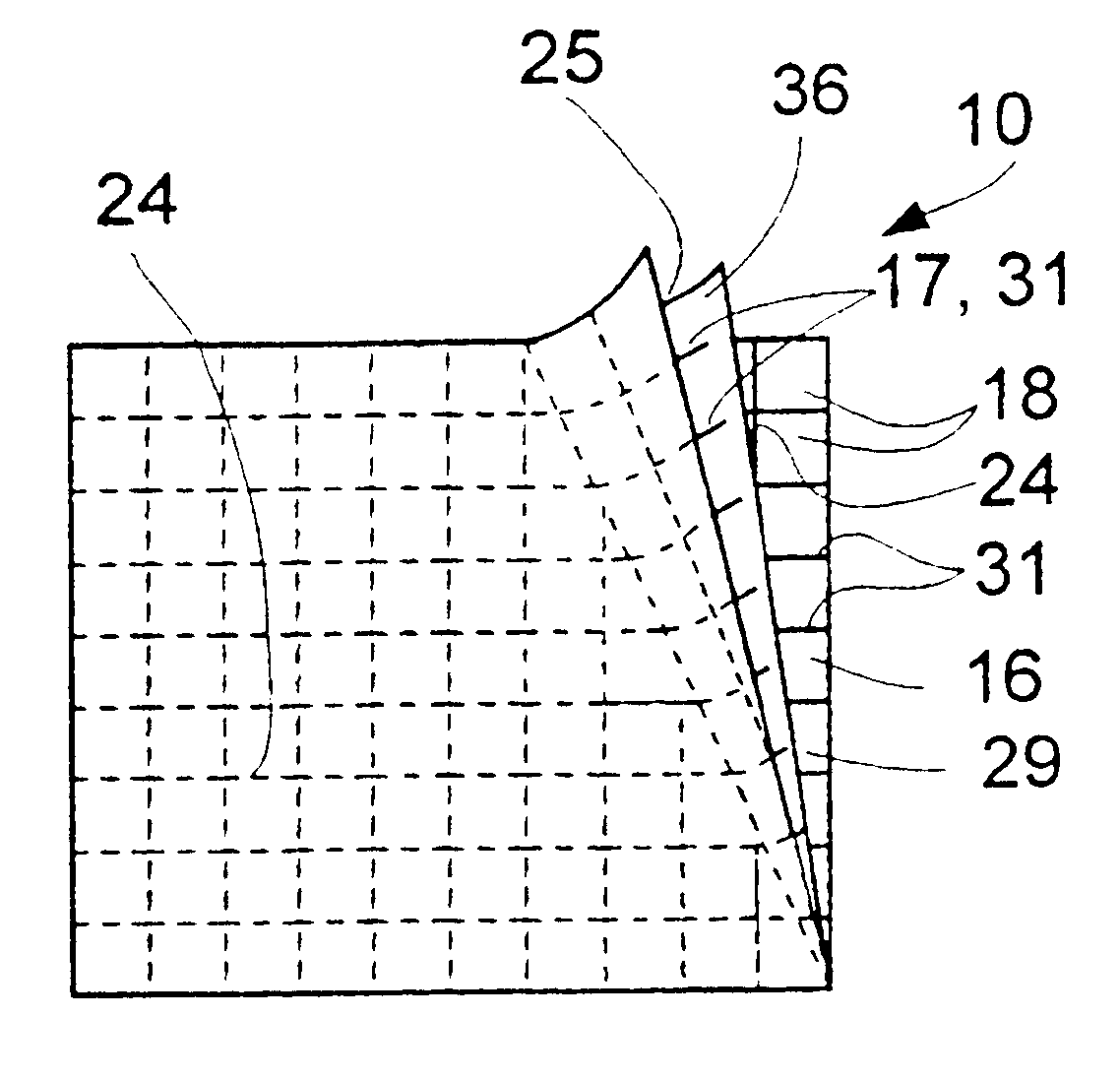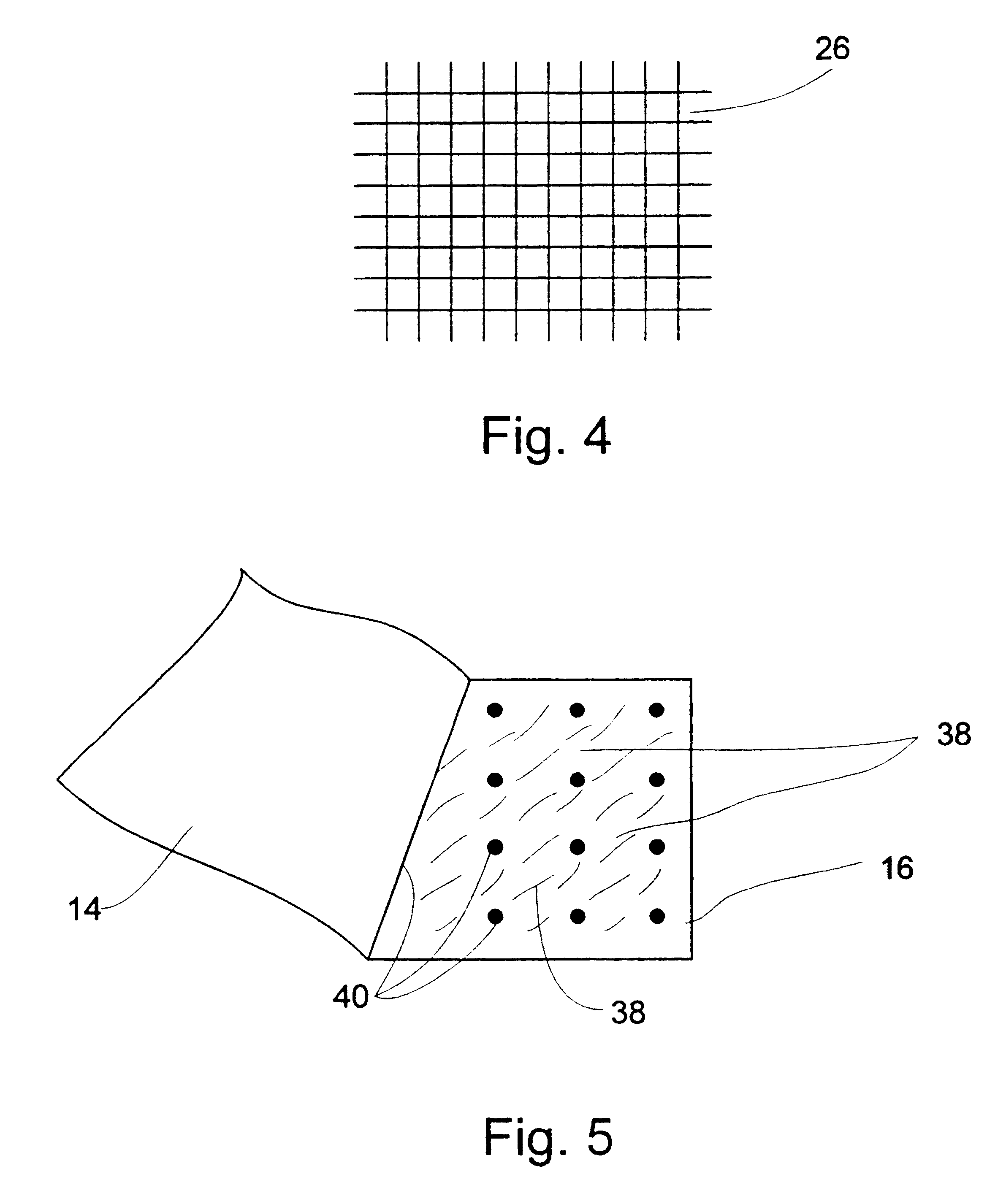Sealing sheet assembly for construction surfaces and methods of making and applying same
a technology of construction surfaces and sealing sheets, applied in the direction of domestic applications, lamination, building components, etc., can solve the problems of affecting the sealing effect of the sealing sheet,
- Summary
- Abstract
- Description
- Claims
- Application Information
AI Technical Summary
Benefits of technology
Problems solved by technology
Method used
Image
Examples
example 2
UPPER LAYER: PVC (Elvaloy.RTM.) made in HA'OGENPLAST grade formulated for use in contact with Bitumen. The layer has a tensile strength of 30 kg / cm and is reinforced with a polyester screen in the center of its cross section. It has a tear strength of about 40 kg / cm.
REINFORCEMENT OF UPPER LAYER: The upper layer comprised of PVC is reinforced with a layer of a woven polyester mesh incorporated in a lower section thereof to form a laminate.
BONDING BETWEEN LAYERS: A pressure sensitive adhesive (Adhestick Israel, Adhestick 703) was applied by spreading and drying between the layer. The adhesive was a self-adhesive pressure-sensitive, non-flammable water-based synthetic elastomer to which was added 5% of a commercial thinner (Adhestick 222).
LOWER LAYER: Foamed cross-linked polyethylene, type PA2 made by PALZIV, Israel. Tensile strength 5 kg / sq. cm, density 50 kg / m.sup.3, elongation at break 230%, water absorption<0.002, allowed operating temperature for sealing purposes -20 to +90.degree...
example 3
UPPER LAYER: Reinforced bitumen 4 mm thick. Tensile strength: 18 kg / cm the layer is reinforced with fibers and a screen of woven polyester.
LOWER LAYER: 3 mm thick foamed cross-linked polyethylene, type PA300 made by PALZIV, Israel. Tensile strength about 2.9 kg / cm.sup.2 density 33 kg / m.sup.3, elongation at break 180% water absorption<0.002, allowed operating temperature for sealing purposes -20 to +90.degree. C.
BONDING BETWEEN LAYERS: Pressure sensitive Bituminous emulsion (Gumiflex.RTM.) with the addition of 30% self-adhesive latex, bitumen fillers and fibers, made by BITUM Israel. 200 gr / m.sup.2 was used. Pressure was applied after drying.
SUBSTRATE: As Example 1.
BONDING TO SUBSTRATE: As Example 1.
TESTS and RESULTS: Test as example 1. No damage to the upper layer. At 3 mm separation the lower layer started tearing. At about 18-20 mm tear in the shear direction began, and separates the lower layer from the upper layer in the upper surface of the lower layer and in the bonding. The u...
PUM
| Property | Measurement | Unit |
|---|---|---|
| elongation | aaaaa | aaaaa |
| area | aaaaa | aaaaa |
| width | aaaaa | aaaaa |
Abstract
Description
Claims
Application Information
 Login to View More
Login to View More - R&D
- Intellectual Property
- Life Sciences
- Materials
- Tech Scout
- Unparalleled Data Quality
- Higher Quality Content
- 60% Fewer Hallucinations
Browse by: Latest US Patents, China's latest patents, Technical Efficacy Thesaurus, Application Domain, Technology Topic, Popular Technical Reports.
© 2025 PatSnap. All rights reserved.Legal|Privacy policy|Modern Slavery Act Transparency Statement|Sitemap|About US| Contact US: help@patsnap.com



